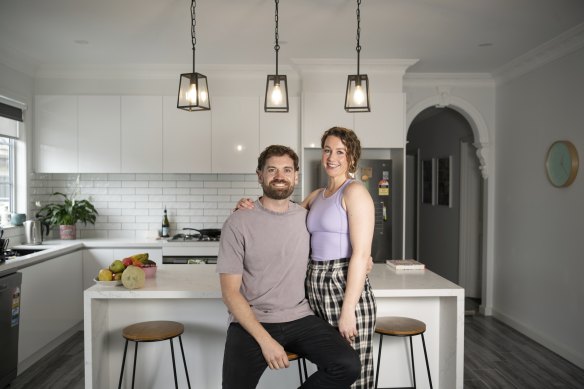Laine bought a unit in a great suburb, but couldn’t upgrade to a house there
Melbourne’s house prices have risen for two quarters in a row, adding another blow to home-buying hopefuls already hampered by rising interest rates.
The latest Domain House Price Report, released on Thursday, shows Melbourne’s median house price rose 0.6 per cent in the September quarter to $1,032,266.
Unit prices were also up for the second quarter this year – by a stronger 3.2 per cent to a median $573,067.
House prices have been supported by a lack of homes for sale and robust growth in population, and experts believe prices will continue to rise, though at a modest rate as higher interest rates continue to squeeze many buyers’ borrowing capacity and more homes are listed in spring.
House and unit prices are now higher than they were a year ago but still below their peaks, said Domain chief of research and economics Dr Nicola Powell.
The market has been resilient, not showing the huge price swings normally seen during a downturn, she said. House prices are down 5.7 per cent since the peak in late 2021.
“Every quarter for the past four quarters prices have either declined a little, or risen by a little, and that highlights the incredible resilience of the Melbourne market,” Powell said.
In the September quarter, median house prices rose most in Melbourne’s outer east, up 3.8 per cent, followed by the north-east (3.2 per cent).
For units, the Mornington Peninsula’s unit prices flew 5.4 per cent higher, and the inner-east and south-east’s unit prices both rose 4.6 per cent.
With Melbourne’s median above $1 million and rises across the city, affordability has taken a hit, Powell said, adding that some buyers find they need to make compromises to be able to purchase.
Others will struggle to get into the market at all.
Laine Delahunty and his wife Harriet Delahunty faced an affordability challenge after looking to buy a house in Kensington where they lived in a unit they owned.
The couple, in their early 30s, widened their search to look for a home in other suburbs, but still found prices were too high. They inspected 40 properties over eight months.
“Most we were disappointed in,” Laine Delahunty said. “We were looking at Kensington, Brunswick and those sorts of areas.

Laine and Harriet Delahunty in their renovated Pascoe Vale home.Credit: Penny Stephens
“We were looking for a three-bedroom house with two bathrooms, but we couldn’t find that because in Kensington and Brunswick, they were too expensive.”
The couple had almost given up, when they found a four-bedroom home in Pascoe Vale, buying the property in June.
Though it wasn’t exactly where they had planned to buy, they were still happy with the outcome – able to afford a bigger four-bedroom home, even though it was further away from the city.
Their mortgage broker Andine Financial Group director Andrew Kostanski said that while the Delahuntys were able to get a loan, many buyers were finding it tough to get finance to buy exactly what and where they wanted.
Some were turning to the bank of mum and dad for help, while others were making compromises.
“Everybody is trying to keep below the 80 per cent level of what they need to borrow, which makes it tough,” Kostanski said. “If they need to borrow more they’re facing $30,000, $40,000 or even $50,000 on mortgage insurance.”
It’s unlikely that prices will ease any time soon said both Powell and the Commonwealth Bank’s head of Australian economics, Gareth Aird.
A booming population and ultra-tight property market had warded off large price declines in Melbourne, with prices expected to remain stable this year. “There is no obvious catalyst for prices to move lower unless the Reserve Bank moves [interest] rates materially higher,” Aird said.
Even an expected rate rise in November would not be enough to push prices lower, he said. A higher than expected inflation rate of 1.2 per cent was reported on Wednesday, and many economists believe another interest rate rise is likely.
“Probably one [rise] in and of itself isn’t enough for prices to fall,” Aird said. “It might take some wind out of the sails. It will be a reminder for borrowers it won’t be the end of the rate tightening cycle.”
Barry Plant Victoria director Mike McCarthy said house prices were remaining up despite more stock coming onto the market during spring.
“A lot of buyers in the first half of the year were frustrated and weren’t looking unless something really good came up, but the increase in stock has bought more buyers back into the market,” McCarthy said.
“The pause in interest rates over the past four months has also seen more confidence return to the market, so there are more buyers absorbing the extra stock.”